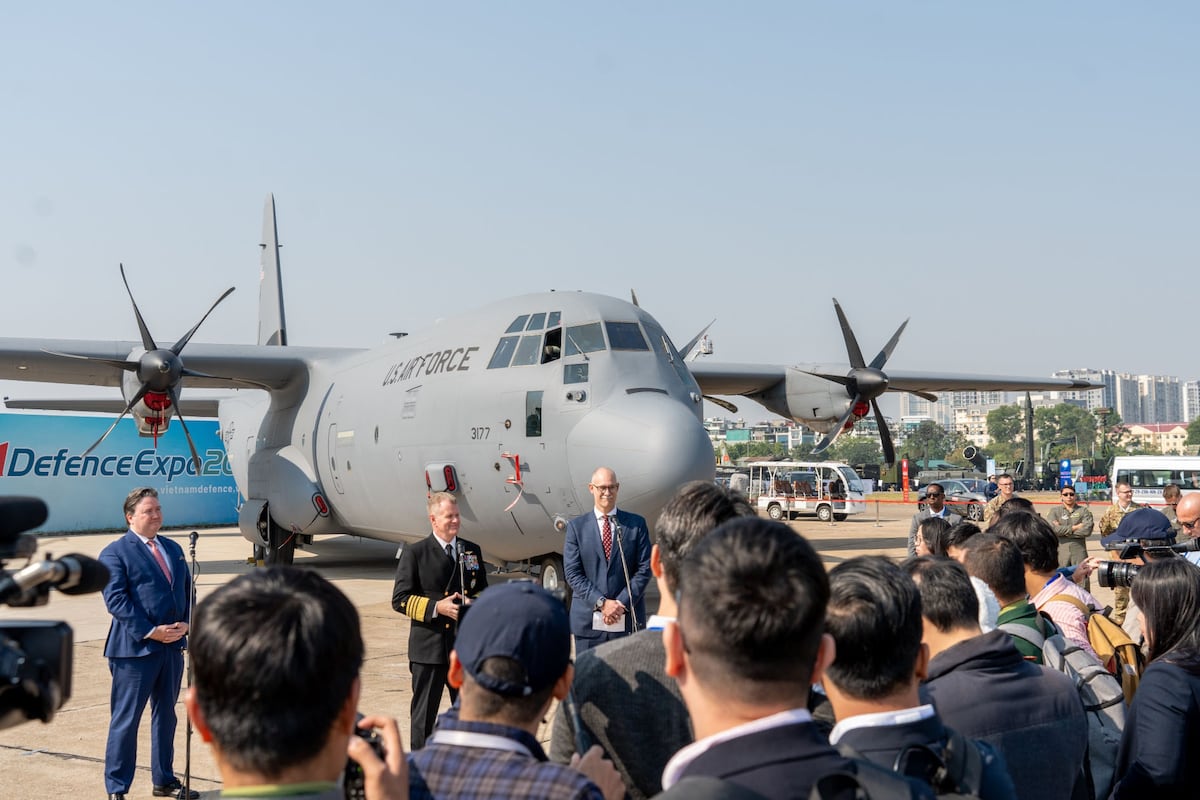HO CHI MINH CITY, Vietnam — Despite U.S. interest in deeper military ties with Vietnam, the Nov. 2 visit by U.S. Defense Secretary Pete Hegseth, during which he met Communist Party leader To Lam and Defense Minister Phan Van Giang, did not yield an expected announcement on arms sales.
“Deeper [military] cooperation will benefit both of our countries,” Hegseth said ahead of his meeting with Giang.
Despite talks in recent years of Vietnam diversifying its predominantly Russian military arsenal and purchasing U.S.-made weapons, no official announcements have been made on major items. Larger efforts to turn away from Russia as its main arms supplier also appear stalled, as reports indicate Hanoi is using profits from a joint oil venture to acquire Russian weapons.
For Washington, Hanoi is seen as a pivotal partner to countering China’s aggression in the South China Sea.
Hegseth’s visit marked 30 years since the countries normalized diplomatic ties in 1995, and two years since the U.S. was upgraded to Hanoi’s highest diplomatic tier, comprehensive strategic partnership. The U.S. lifted its arms embargo on Vietnam in 2016 and has since delivered three cutters to the Vietnamese coast guard and three T-6C trainer aircraft out of an order of 12.
During Hegseth’s trip, the countries signed a memorandum of understanding on war legacy cooperation. Hegseth announced a $130 million commitment to funding the cleanup of the toxic herbicide Agent Orange, sprayed to destroy jungle foliage during the Vietnam War that continues to cause birth defects among Vietnamese. The funding would also go to clearing unexploded ordnance as well as finding and identifying the remains of American and Vietnamese soldiers. Those efforts were paused after the Trump administration froze U.S. Agency for International Development funds this year.
At the end of his meeting with Giang, Hegseth gave the defense minister a leather box, knife and belt U.S. soldiers had taken from a Vietnamese bunker outside the coastal city of Danang in 1968.
Andrew Wells-Dang, senior adviser to the nonprofit Mission: POW-MIA, said Hegseth’s visit signals that the US-Vietnam partnership continues despite tariff disputes.
“Its significance is that both countries recognize war legacy issues, including the search for missing persons from both sides, is the foundation for security relations,” he told Military Times by WhatsApp.
“This has always been the case for the Vietnamese of course, and it’s important that the U.S. officials agree too,” he wrote.
Nguyen Khac Giang, a visiting fellow at Singapore’s ISEAS-Yusof Ishak Institute, told Military Times that the commitment on war remediation was positive but there appeared to be little movement on arms sales.
“On the defense cooperation, we have seen a lot of talks and promises but we haven’t seen anything really concrete,” he said.
While no arms purchase was announced, Lam, the party leader, described defense cooperation as key to the countries’ partnership. He called defense cooperation “one of the most important pillars of bilateral relations,” the local Voice of Vietnam outlet reported, and he urged continued U.S. support for postwar recovery and for “substantive defense cooperation on the basis of respecting Vietnam’s independence, sovereignty, territorial integrity, foreign and defense principles.”
Stalled arms deals?
Beyond official statements, reports indicate deeper talks on arms supplies are in the works. Two unnamed Vietnamese sources and one unnamed U.S. official told Reuters weapons procurement would dominate the Hegseth visit agenda, including possible purchase of Lockheed Martin C-130 Hercules cargo planes and S-92 helicopters and Boeing Chinook helicopters, but neither Lockheed Martin nor the U.S. Embassy in Hanoi would comment. The Vietnamese Embassy in Washington did not reply to questions.
In April, Hanoi said it would buy at least 24 Lockheed Martin F-16 fighter jets but no progress has been reported. The potential C-130 deal surfaced in September of last year after Defense Minister Giang visited Washington. Later, at Hanoi’s December Defense Expo, Vietnam’s deputy defense minister was filmed saying Hanoi had ordered the cargo planes.
Ray Powell, executive director of Indo-Pacific-focused maritime transparency nonprofit SeaLight and former U.S. air attaché to Vietnam, said F-16 sales are unlikely because of Chinese pressure.
“If Vietnam were to buy US F-16s that would certainly aggravate China,” he said. C-130s, as nonlethal cargo planes, would be less likely to rankle Beijing, he said, adding that similar thinking went into the U.S. supplying Vietnam with T-6C training aircraft, an effort led by Powell while air attaché.
“Part of the reason we picked the T-6 as the way to go is because politically it’s not nearly as sensitive as something like a fighter,” he said.
Nguyen Khac Giang said the C-130 deal is likely bogged down by bureaucracy but that the delays could also signify deeper trust issues, especially amid reports that Hanoi is purchasing Russian fighter jets.
“The case of the C-130 is a very obvious delay in defense cooperation,” he said. “It’s mostly bureaucratic hurdles but, nevertheless, if you put that into the comparison with Vietnam’s recent alleged purchase of 40 Su fighters from Russia, I think that may signal some potential trust issues between the two sides.”
Russian arms reports
In September, the Associated Press reported that Hanoi planned to buy Russian weapons through profits from Rusvietpro – a joint oil venture with Russia’s Zarubezhneft – to skirt sanctions by bypassing the international SWIFT network for financial transactions.
In October, The New York Times reported that Hanoi had ordered $8 billion worth of Russian arms, including 40 new Su-35 and Su-30 fighter jets, though deliveries would be delayed by Moscow’s war on Ukraine. Leaked data from hacker group black8mirror in September indicated Vietnam was set to receive nine electronic warfare systems in 2024, and 26 components for mobile ground-based systems that can jam radar-guided missiles this year.
Despite Russian weapons’ lower quality, Powell said the dependence on Russian weapons stems from shared history, corruption and cost incentives.
“Vietnam has been buying Russian weapons for generations and so some of it I think is inertia,” Powell said.
“They know that they have to end up going back and paying more for repairs and parts [for Russian weapons]. … It’s just when the price point for the initial purchase is cheaper, it’s harder to justify buying the expensive Western product when you can get the cheaper Russian product. Also, again, there are people who get paid, and that’s just a fact.”
Washington appears to be looking the other way on Vietnam purchasing Russian weapons because Hanoi is key to countering Beijing’s growing regional power, he said.
“Geopolitically, we don’t want to alienate these potential partners,” Powell said. “We want these guys with us.”
As Southeast Asian nations are frustrated by policy uncertainty, Nguyen Khac Giang said he sees Hanoi making diplomatic gestures showing its solidarity with Cold War allies.
In October, To Lam went to North Korea, the first official visit by a Vietnamese leader in decades. Meanwhile, Lam attended a Red Square military parade in May.
“The trust of U.S. strategic reliability in Southeast Asia has declined quite significantly,” Giang said.
“It’s the unpredictable policy terms, whether it’s tariff policy, or trade, or USAID.”
“This makes Vietnam think twice in terms of upgrading their defense cooperation with the U.S. because they don’t know what will happen next year or even next month,” he added.
“This kind of uncertainty is very harmful to U.S. interests in making their allies and partners in the region in regards to the great power competition with China,’’ he said.
Meanwhile, Collin Koh Swee Lean, senior fellow at Singapore’s Institute of Defence and Strategic Studies, said Hanoi must balance maintaining close ties with China, building ties with the U.S., and working with its neighbors to counter their “common adversary” at sea – Beijing.
“Hanoi has been navigating it quite deftly, it’s trying to manage all sides at once,” he said. “The sort of consensus that [South China Sea claimants] have arrived at is: ‘You do what you need to do, I’ll do what I need to do, and we just remember that we have one common problem in mind, which is China.’”
Read the full article here








